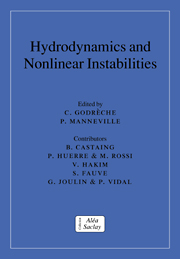Book contents
- Frontmatter
- Contents
- Preface
- Contributors
- Overview
- 1 An introduction to hydrodynamics
- 2 Hydrodynamic instabilities in open flows
- 3 Asymptotic techniques in nonlinear problems: some illustrative examples
- 4 Pattern forming instabilities
- 5 An introduction to the instability of flames, shocks, and detonations
- Index
2 - Hydrodynamic instabilities in open flows
Published online by Cambridge University Press: 04 November 2009
- Frontmatter
- Contents
- Preface
- Contributors
- Overview
- 1 An introduction to hydrodynamics
- 2 Hydrodynamic instabilities in open flows
- 3 Asymptotic techniques in nonlinear problems: some illustrative examples
- 4 Pattern forming instabilities
- 5 An introduction to the instability of flames, shocks, and detonations
- Index
Summary
Introduction
The objective of the following lecture notes is to provide a consistent account of the development of hydrodynamic instabilities in open flows such as mixing layers, wakes and boundary layers. These prototype shear flows are commonly encountered in a variety of technological applications in aerodynamics, mechanical and chemical engineering, and in many geophysical processes in the oceans and atmospheres. A physical understanding of the transition to turbulence in “simple” shear flows gives rise to fundamental issues that constitute the core of this course.
Flows are typically classified according to their open or closed nature and to their laminar or turbulent character. In open flows, fluid particles are not recycled within the physical domain of interest but leave it in a finite time (Huerre and Monkewitz, 1990), as in the mixing layer generated downstream of a splitter plate by the merging of two parallel streams in relative motion. By contrast, in closed flows, fluid particles always remain within the same physical region, as in Taylor–Couette flow between two counter-rotating cylinders (Andereck et al., 1986). The distinction between laminar and turbulent flows is related to the degree of spatial and temporal coherence of a given flow (Tennekes and Lumley, 1972; Monin and Yaglom, 1975; Landau and Lifshitz, 1987a; Lesieur, 1991; Frisch, 1995). Typically, turbulent flows arise at high Reynolds numbers and are characterized by the presence of a wide range of spatial and temporal scales, three-dimensional vorticity fluctuations and a certain degree of unpredictability.
Information
- Type
- Chapter
- Information
- Hydrodynamics and Nonlinear Instabilities , pp. 81 - 294Publisher: Cambridge University PressPrint publication year: 1998
Accessibility standard: Unknown
Why this information is here
This section outlines the accessibility features of this content - including support for screen readers, full keyboard navigation and high-contrast display options. This may not be relevant for you.Accessibility Information
- 132
- Cited by
